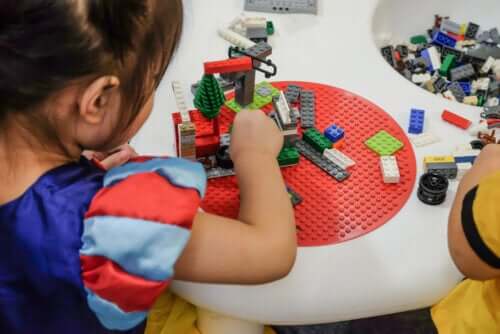The Torrance Test of Creative Thinking


Written and verified by the psychologist Ana Couñago
Many children stand out for their creativity and imagination. Some of them even hide artistic talent. But, how can we evaluate creative thinking in children? In this article, we’ll show you how.
In order to assess creativity, you’ll find verbal tasks, in which children have to come up with solutions to different problems or situations; and non-verbal tasks, in which children have to draw different things. The Torrance test of creative thinking (TTCT) is a psychometric test, which includes the two types of tests previously mentioned.
“Creativity is about running away from what’s obvious, safe and predictable in order to create something new.”
– Joy Paul Guilford –
What is creativity?
According to Ellis Paul Torrance, American psychologist, creativity can be identified as:
“Creativity is the process of sensing problems or gaps in information, then identifying the difficulties and seeking solutions through trial and error or through forming hypothesis.”
– Ellis Paul Torrance –

Additionally, the same author states that in order to talk about creativity, you have to take these four elements into account:
- Fluency: the ability to come up with a large number of answers, solutions or ideas to the same problem.
- Flexibility: the ability to recognize different interpretations or points of view, and thus proposing contrasting solutions. This means changing approaches and employing several problem-solving strategies.
- Originality: the skill for thinking differently, thus coming up with innovative and unconventional answers to different situations.
- Elaboration: the ability to develop, complete and improve creative answers, paying strong attention to detail and sophistication.
The Torrance test of creative thinking for children
The Torrance test of creative thinking is a psychometric test, which aims to assess figurative and verbal creativity in children. This test scores on four levels: fluency (number of answers), flexibility (variety in the answers), originality (innovation) and elaboration (level of detail).
Therefore, the Torrance test consists of two parts:
- Verbal part.
- Figurative expressions part.

Verbal part of the Torrance test of creative thinking for children
The verbal part of the Torrance test requires the production of written answers. Therefore, it contains activities of:
- Questions and answers: children look at an image, and they have to write down all the questions that come to their minds at that moment. They also have to guess or assume different causes and effects of the image they’re looking at.
- Unusual uses: children have to make a list of the different uses or utilities of a certain object (a box, a bag, etc.).
- Improvement task: it’s about writing down ideas to improve a toy and to change it in order to make it more fun.
Figurative expression part of the Torrance test of creative thinking for children
In this case, children have to draw the answers. This part consists of three activities children must carry out:
- Picture construction task: children are given a piece of paper with the shape of a banana or a bean, and they have to draw something and integrate it with the piece of paper. In addition, they have to pick a name for their creation.
- Incomplete figures task: in this case, children must finish a series of incomplete images, and then, choose a name for the drawings they’ve completed.
- Compose a different drawing parting from parallel lines: it consists of creating the biggest number of drawings parting from parallel lines. Finally, they have to pick a name for their creations.
Many children stand out for their creativity and imagination. Some of them even hide artistic talent. But, how can we evaluate creative thinking in children? In this article, we’ll show you how.
In order to assess creativity, you’ll find verbal tasks, in which children have to come up with solutions to different problems or situations; and non-verbal tasks, in which children have to draw different things. The Torrance test of creative thinking (TTCT) is a psychometric test, which includes the two types of tests previously mentioned.
“Creativity is about running away from what’s obvious, safe and predictable in order to create something new.”
– Joy Paul Guilford –
What is creativity?
According to Ellis Paul Torrance, American psychologist, creativity can be identified as:
“Creativity is the process of sensing problems or gaps in information, then identifying the difficulties and seeking solutions through trial and error or through forming hypothesis.”
– Ellis Paul Torrance –

Additionally, the same author states that in order to talk about creativity, you have to take these four elements into account:
- Fluency: the ability to come up with a large number of answers, solutions or ideas to the same problem.
- Flexibility: the ability to recognize different interpretations or points of view, and thus proposing contrasting solutions. This means changing approaches and employing several problem-solving strategies.
- Originality: the skill for thinking differently, thus coming up with innovative and unconventional answers to different situations.
- Elaboration: the ability to develop, complete and improve creative answers, paying strong attention to detail and sophistication.
The Torrance test of creative thinking for children
The Torrance test of creative thinking is a psychometric test, which aims to assess figurative and verbal creativity in children. This test scores on four levels: fluency (number of answers), flexibility (variety in the answers), originality (innovation) and elaboration (level of detail).
Therefore, the Torrance test consists of two parts:
- Verbal part.
- Figurative expressions part.

Verbal part of the Torrance test of creative thinking for children
The verbal part of the Torrance test requires the production of written answers. Therefore, it contains activities of:
- Questions and answers: children look at an image, and they have to write down all the questions that come to their minds at that moment. They also have to guess or assume different causes and effects of the image they’re looking at.
- Unusual uses: children have to make a list of the different uses or utilities of a certain object (a box, a bag, etc.).
- Improvement task: it’s about writing down ideas to improve a toy and to change it in order to make it more fun.
Figurative expression part of the Torrance test of creative thinking for children
In this case, children have to draw the answers. This part consists of three activities children must carry out:
- Picture construction task: children are given a piece of paper with the shape of a banana or a bean, and they have to draw something and integrate it with the piece of paper. In addition, they have to pick a name for their creation.
- Incomplete figures task: in this case, children must finish a series of incomplete images, and then, choose a name for the drawings they’ve completed.
- Compose a different drawing parting from parallel lines: it consists of creating the biggest number of drawings parting from parallel lines. Finally, they have to pick a name for their creations.
All cited sources were thoroughly reviewed by our team to ensure their quality, reliability, currency, and validity. The bibliography of this article was considered reliable and of academic or scientific accuracy.
- Garaigordobil-Landazabal, M. (2005). Diseño y evaluación de un programa de intervención socioemocional para promover la conducta prosocial y prevenir la violencia. Ministerio de Educación y Ciencia. CIDE. España, 271.
- Jiménez, J. E., Artiles, C., Rodríguez, C. y García, E. (2007). Adaptación y baremación del test de pensamiento creativo de Torrance: expresión figurada. Educación primaria y secundaria. Canarias: Consejería de educación, cultura y deportes del Gobierno de Canarias.
This text is provided for informational purposes only and does not replace consultation with a professional. If in doubt, consult your specialist.








